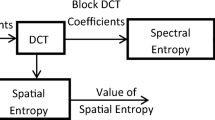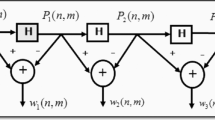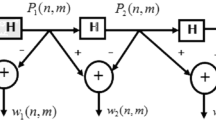Abstract
The objective of any night vision system is to enable a person to see in the dark. A low-contrast image puts a contrast constraint on the human observer visibility at night. This is the basic reason for the large number of accidents at night. This research presents two proposed approaches to enhance the visibility of the infrared (IR) night vision images through an efficient histogram processing. The first approach is based on contrast limited adaptive histogram equalization. The second proposed approach depends on histogram matching. The histogram matching uses a reference visual image for converting night vision images into good quality images. The obtained results are evaluated with quality metrics such as entropy, average gradient, contrast improvement factor and sobel edge magnitude.











Similar content being viewed by others
References
Hollnagel, E., & Kallhammer, J. E. (2003). Effects of a night vision enhancement system (NVES) on driving: Results from a simulator study. Driving Assessment Conference, University of Linkoping, Autoliv Research, Sweden.
Grag, R., Mittal, B., & Grag, S. (2011). Histogram equalization techniques for image enhancement. International Journal of Electronics & Communication Technology, 2(1), 107–111.
Rabin, J., & Wiley, R. (1994). Switching from forward-looking infrared to night-vision goggles: Transitory effects on visual resolution. Aviation, Space, and Environmental Medicine, 65, 327–329.
Zimmerman, J. B., Pizer, S. M., Staab, E. V., Perry, J. R., McCartney, W., & Brenton, B. C. (1988). An evaluation of the effectiveness of adaptive histogram equalization for contrast enhancement. Report Number: WUCS-87-31 (1987). All Computer Science and Engineering Research. http://openscholarship.wustl.edu/cse_research/817.
Gonzalez, R., & Wood, R. (2009). Digital image processing (Vol. 3). London: Pearson Education.
LCEO Night Vision Equipment. (2003). The principles of Night Vision. http://www.squonk.net/users/lceo/NVworks.htm.
Hel-Or, Y., Hel-Or, H., & David, E. (2011). Fast template matching in non-linear tone-mapped images. In Computer vision (ICCV), international conference on IEEE (pp. 1355–1362).
Russ, J. C. (2007). The image processing handbook (5rd edn.). CRC Press.
Rolland, J. P., Vo, V., Bloss, B., & Abbey, C. K. (2000). Fast algorithms for histogram matching: Application To texture synthesis. Journal of Electronic Imaging, 9(1), 39–45.
Shome, S. K., & Vadali, S. R. K. (2011). Enhancement of Di-abetic retinopathy imagery using contrast limited adaptive histogram equalization. International Journal of Computer Science and Information Technologies, 2(6), 2694–2699.
Stark, J. A. (2000). Adaptive image contrast enhancement using generalizations of histogram equalization. IEEE Transactions on Image Processing, 9(5), 889–894. doi:https://doi.org/10.1109/83.841534.
Zhiming, W., & Jianhua, T. (2006). A Fast implementation of adaptive histogram equalization In IEEE, ICSP proceedings.
Yoo, J., Ohm, S., & Chung, M. (2012). Maximum-entropy image enhancement using brightness mean and variance. Journal of Korean Society for Internet Information, 13(3), 61–73.
Renukalatha, S., & Suresh, K. V. (2016). Brain tumor analysis of Rician noise affected MRI images. International Journal of Computer Applications, 141(14), 0975–8887.
Author information
Authors and Affiliations
Corresponding author
Rights and permissions
About this article
Cite this article
Ashiba, H.I., Mansour, H.M., Ahmed, H.M. et al. Enhancement of Infrared Images Based on Efficient Histogram Processing. Wireless Pers Commun 99, 619–636 (2018). https://doi.org/10.1007/s11277-017-4958-9
Published:
Issue Date:
DOI: https://doi.org/10.1007/s11277-017-4958-9




